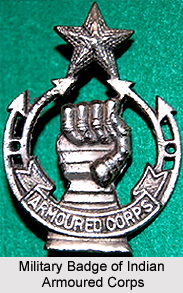 The Indian Armoured Corps was one of the major armed units of the Indian Army under the administrative control of the British Crown. The regiment was formed on 1 May 1941. The Corps was developed for the purpose of distributing existing armoured regiments within the British Indian Army. The headquarters of the Indian Armoured Corps was established at Ferozepore.
The Indian Armoured Corps was one of the major armed units of the Indian Army under the administrative control of the British Crown. The regiment was formed on 1 May 1941. The Corps was developed for the purpose of distributing existing armoured regiments within the British Indian Army. The headquarters of the Indian Armoured Corps was established at Ferozepore.
History of Indian Armoured Corps
The nation achieved freedom from the political dominance of British Empire in India on 15th August 1947. As a result, the former British India was separated into 2 sovereign parts, namely the Union of India and Dominion of Pakistan. Accordingly the assets and the military personnel of the British Indian Army were divided among Pakistani Army and the modern Indian Army. The Indian Armoured Corps was also shared amongst the army of the 2 newly independent nations. Around two-thirds of the regiment was developed as the current Indian Army Armoured Corps and merely one third of the former Corps became the Pakistan Armoured Corps.
Development of Indian Armoured Corps
At present, the Indian Army Armoured Corps serves as one of the combat arms of present Indian Army. The unit consists of 63 armoured commands, which also includes the President`s Bodyguards unit. The Armoured Corps School and Centre was established at Ahmednagar in Maharashtra, India. Traditionally every Armoured Regiment comprises of a Colonel of the Regiment, which is an honorary position. The senior officer holding the post supervises the regimental matters of the unit.
Regiments of the Indian Army Armoured Corps
The following is a list of the various regiments that are included as a part of the Indian Army Armoured Corps-
* President`s Bodyguard
* 1 Horse (Skinner`s Horse)
* 2nd Lancers (Gardner`s Horse)
* 3 Cavalry Flamingoes
* 4 Horse (also known as the 4th Duke of Cambridge`s Own Hodson`s Horse)
* 5 Armoured Regiment
* 6 Armoured Regiment
* 7th Light Cavalry
* 8th Light Cavalry (also known as the 8th King George`s Own Light Cavalry)
* 9 Horse (also known as the 9th Royal Deccan Horse)
* 10 Armoured Regiment
* 11 Armoured Regiment
* 12 Armoured Regiment
* 13 Armoured Regiment
* 14 Horse (Scinde Horse)
* 15 Armoured Regiment
* 16th Light Cavalry
* 17 Horse (The Poona Horse) Fakr-e-Hind
* 18 Cavalry
* 19 Armoured Regiment
* 20 Lancers
* Central India Horse Positioned
* 40 Armoured Regiment
* 41 Armoured Regiment
* 42 Armoured Regiment
* 43 Armoured Regiment
* 44 Armoured Regiment
* 45 Cavalry
* 46 Armoured Regiment Raised
* 47 Armoured Regiment
* 48 Armoured Regiment
* 49 Armoured Regiment
* 50 Armoured Regiment
* 51 Armoured Regiment
* 52 Armoured Regiment
* 53 Armoured Regiment
* 56 Armoured Regiment
* 61 Cavalry
* 62 Cavalry
* 63 Cavalry
* 64 Cavalry
* 65 Armoured Regiment
* 66 Armoured Regiment
* 67 Armoured Regiment
* 68 Armoured Regiment
* 69 Armoured Regiment
* 70 Armoured Regiment
* 71 Armoured Regiment
* 72 Armoured Regiment
* 73 Armoured Regiment
* 74 Armoured Regiment
* 75 Armoured Regiment
* 76 Armoured Regiment
* 81 Armoured Regiment
* 82 Armoured Regiment
* 83 Armoured Regiment
* 84 Armoured Regiment
* 85 Armoured Regiment
* 86 Armoured Regiment
* 87 Armoured Regiment
* 88 Armoured Regiment
* 89 Armoured Regiment
* 90 Armoured Regiment



















